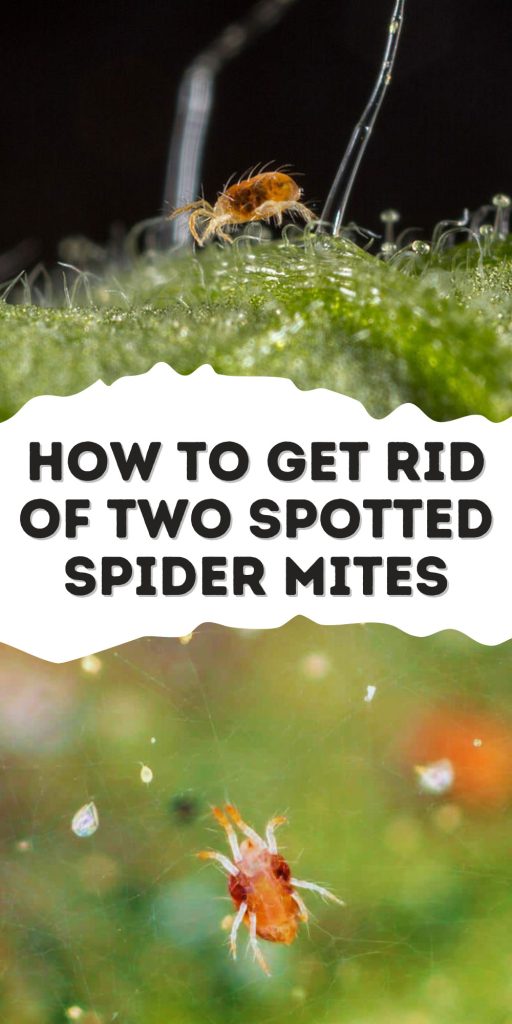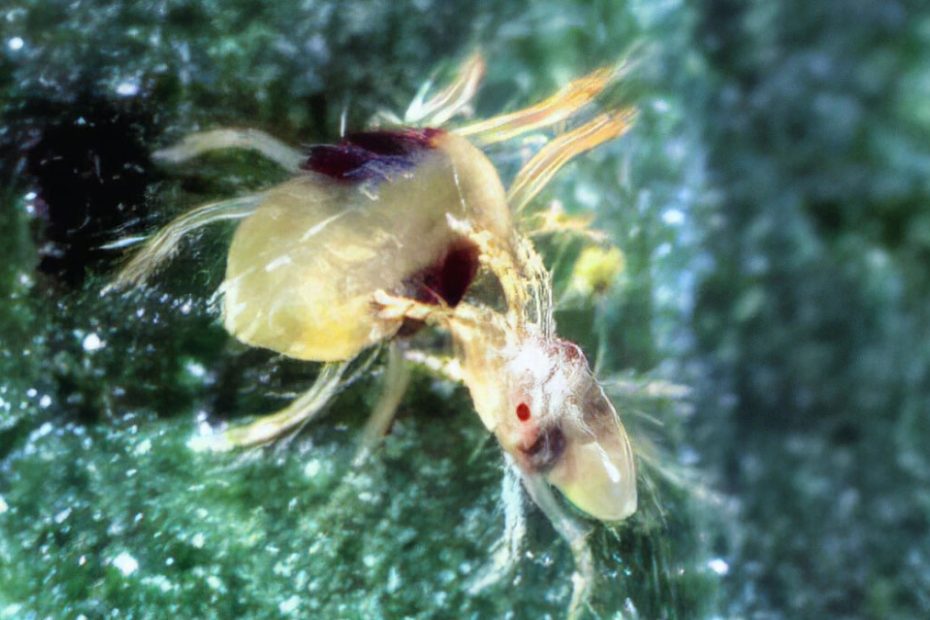If you’ve noticed tiny, moving dots on your plants and delicate webs forming on the undersides of leaves, you’re likely dealing with two-spotted spider mites. These tiny pests can wreak havoc on your garden, causing leaves to yellow and drop prematurely. It’s essential to act quickly to prevent them from spreading and causing further damage.
Key Takeaways
- Identification: Two-spotted spider mites are tiny pests identifiable by their pale green to yellow color and two dark spots near the front of their bodies. Look for fine webs and stippling or yellowing patterns on leaves.
- Life Cycle: These mites thrive in hot, dry conditions and have a rapid life cycle. Females can lay hundreds of eggs on leaves, leading to quick population growth. Regular inspection is crucial.
- Early Signs: Common symptoms include speckled leaves, yellowing, premature leaf drop, and webbing. Use magnifying glasses, sticky traps, and white paper tests for early detection.
- Natural Control: Introduce predatory insects like ladybugs and predatory mites or use homemade sprays like soap solution, neem oil, and garlic spray to manage infestations effectively.
- Chemical Treatments: When natural methods aren’t enough, choose specific acaricides or insecticidal soaps and follow safe application practices such as wearing protective clothing and treating plants during cooler hours.
- Preventive Measures: Maintain plant health with proper watering, pruning, and nutrient management. Adjust environmental factors like humidity and spacing to create less favorable conditions for mites. Regularly inspect new plants and control weeds.

Understanding Two Spotted Spider Mites
Recognizing two-spotted spider mites involves understanding their characteristics and behaviors. These pests can seriously damage plants, making early identification crucial.
Appearance and Identification
Two-spotted spider mites (Tetranychus urticae) are tiny, often less than 0.5 millimeters long. You can identify them by the following features:
- Body Color: Usually pale green to yellow, but can turn reddish or brown under certain conditions.
- Spots: Two distinctive dark spots near the front of the body, though they may not be visible without magnification.
- Webbing: Fine, silk-like webs spun on the undersides of leaves, often more noticeable in severe infestations.
To spot these mites, check both sides of the leaves and look for stippling or yellowing patterns, which indicate feeding damage.
Life Cycle and Habits
Understanding their life cycle and habits helps effectively manage two-spotted spider mites. These mites go through five stages: egg, larva, protonymph, deutonymph, and adult.
- Eggs: The female lays hundreds of spherical eggs on leaf surfaces. Eggs hatch within three days at optimal temperatures (80-90°F).
- Larvae: Larvae emerge, having three pairs of legs. They feed on plant cells for a few days before molting.
- Nymphs: Protonymphs and deutonymphs have four pairs of legs and continue feeding and molting. They reach adulthood within a week.
- Adults: Adults, typically live for about two to four weeks and can lay up to 20 eggs per day.
These mites thrive in hot, dry conditions. They can complete a life cycle in as few as seven days, leading to rapid population growth. They move between plants by crawling or being carried by the wind.
Incorporate regular inspection of plants and environmental control to manage infestations. Identify early signs and understand their behavior to act promptly.
Early Signs of Infestation
Detecting an infestation early is crucial for effective control. You’ll find that quick identification can prevent widespread damage and save your plants.
Common Symptoms in Plants
Two-spotted spider mites cause noticeable symptoms. Look for these early signs:
- Speckled Leaves: Tiny, pale spots on leaves can indicate feeding damage.
- Yellowing: Leaves may turn yellow and lose their green vibrancy.
- Premature Leaf Drop: Infested leaves may fall off earlier than usual.
- Webbing: Fine, delicate webs, particularly on the undersides of leaves.
Tools for Detection
Having the right tools helps you identify infestations:
- Magnifying Glass: Use a magnifying glass to inspect leaves closely.
- Sticky Traps: Place yellow sticky traps near plants to monitor mite activity.
- White Paper Test: Tap a leaf over white paper to see if any mites fall off.
Regularly inspecting your plants with these tools can aid in early detection, keeping your garden healthy and pest-free.
Natural Methods for Control
Swift action is crucial in managing two-spotted spider mites. Use natural methods to minimize environmental impact and avoid chemical residues on plants.
Predatory Insects
Introducing natural predators can significantly reduce spider mite populations. Predatory insects are effective biological controls. Common predators include:
- Ladybugs: Known for their voracious appetite, especially at the larval stage, ladybugs can consume large quantities of mites.
- Predatory Mites (Phytoseiulus persimilis): These are specialists in preying on spider mites. Release them onto infested plants for targeted control.
- Lacewings: Their larvae, often called aphid lions, feed on mite nymphs and adults.
Providing habitats such as flowering plants can attract these beneficial insects to your garden.
Homemade Sprays and Solutions
You can create effective sprays using household ingredients to control spider mites while minimizing harm to beneficial insects.
- Soap Spray: Mix 2 tablespoons of mild liquid soap in 1 quart of water. Spray directly on the mites, ensuring coverage under leaves. The soap suffocates the mites by disrupting their cell membranes.
- Neem Oil: Dilute 2 tablespoons of neem oil in 1 gallon of water, adding a few drops of dish soap to emulsify. Apply liberally to infested areas. Neem oil acts as an insect growth regulator, disrupting mite reproduction.
- Garlic Spray: Crush 4-5 garlic cloves and steep in 1 quart of water for several hours. Strain and spray the solution onto plants. Garlic contains sulfur compounds that repel mites.
These methods provide effective, natural alternatives to chemical pesticides. Regular application and monitoring enhance their efficacy. Combine with predatory insects for comprehensive control of two-spotted spider mites.
Chemical Treatments
Chemical treatments can effectively control two-spotted spider mite infestations when used correctly. Choosing the right pesticide and following safe application tips are crucial for achieving desired results and minimizing risks.
Choosing the Right Pesticide
Selecting the appropriate pesticide involves understanding the specific needs and conditions of your garden. Here’s a list to guide your choice:
- Acaricides: Pesticides specifically designed to target mites. Example: Bifenazate.
- Insecticidal Soaps: Safe for most plants and break down quickly. Example: Safer Brand Soap.
- Horticultural Oils: Effective in disrupting mite life cycles by smothering eggs and larvae. Example: Neem Oil.
- Biological Controls: Pesticides derived from natural sources, or organisms that prey on spider mites. Example: Spinosad.
Read the label to ensure the product suits your particular infestation and plant type.
Safe Application Tips
Applying chemical treatments requires careful attention to safety to protect yourself, your plants, and the environment. Follow these essential steps:
- Wear Protective Clothing: Use gloves, masks, and long sleeves to avoid direct contact with chemicals.
- Follow Manufacturer Instructions: Adhere to the specified amounts and methods to prevent damage and overuse.
- Treat During Cooler Hours: Apply in the early morning or late evening to minimize evaporation and maximize effectiveness.
- Avoid Windy Days: Apply when wind speeds are low to prevent drift and accidental exposure.
- Rotate Chemicals: Alternate between different types to reduce the risk of mites developing resistance.
Combine these practices with regular monitoring to ensure effective control and maintain a healthy garden.
Preventive Measures
Preventing a two-spotted spider mite infestation is more manageable and less harmful to your plants than treating an existing one. By following key preventive measures, you can maintain your garden’s health and reduce the likelihood of a mite outbreak.
Proper Plant Care
Ensuring your plants are healthy and resilient makes them less susceptible to pest invasions. Regular care creates an unfavorable environment for two-spotted spider mites.
- Regular Watering: Keep your plants well-watered to lessen stress. Mites thrive in dry conditions.
- Pruning: Remove old, dead, or infested leaves to reduce hiding spots for mites.
- Nutrient Management: Feed plants adequately. Over-fertilizing with nitrogen can lead to soft, succulent growth favored by mites.
- Inspecting New Plants: Always check new plants for signs of mites before introducing them to your garden.
Including these practices in your regular gardening routine fosters a robust environment that deters pests.
Environmental Adjustments
Modifying the environment helps in reducing mite infestations. Understanding what makes your garden less appealing to mites enables proactive management.
- Humidity Control: Increase humidity around plants. Two-spotted spider mites prefer dry conditions. Mist plants or use a humidifier.
- Spacing: Ensure proper spacing between plants to promote air circulation and reduce the likelihood of mite colonies.
- Mulching: Apply mulch to retain soil moisture and create a less favorable habitat for mites.
- Weed Control: Remove weeds which can host spider mites and help their spread to other garden plants.
Implementing these environmental control strategies combined with proper plant care can significantly reduce the likelihood of two-spotted spider mite infestations. Regular monitoring and consistent preventive practices keep your garden thriving and pest-free.
Conclusion
Dealing with two-spotted spider mites requires a proactive and multifaceted approach. By regularly inspecting your plants and using natural methods like introducing predatory insects and homemade sprays, you can effectively manage these pests. Chemical treatments can also be valuable when applied correctly and safely.
Preventive measures play a crucial role in maintaining a healthy garden. Proper plant care and environmental adjustments create an inhospitable environment for mites. Combining these strategies ensures your garden remains vibrant and pest-free.
Frequently Asked Questions
What are the common signs of a two-spotted spider mite infestation?
Common signs include speckled leaves, yellowing, premature leaf drop, and delicate webs on the underneath of leaves. Regular inspections are crucial for early detection.
How can I identify two-spotted spider mites on my plants?
Two-spotted spider mites are tiny, less than 0.5 mm long, and can appear pale green, yellow, reddish, or brown. Look for two dark spots near the front of their bodies and fine silk-like webs on leaves.
What tools can help in detecting two-spotted spider mites?
Tools like a magnifying glass for close inspection, yellow sticky traps to monitor activity, and the white paper test (shaking leaves over white paper to see falling mites) aid in early detection.
What natural methods are effective in controlling two-spotted spider mites?
Introduce predatory insects like ladybugs, predatory mites, and lacewings. Use homemade sprays such as soap spray, neem oil, and garlic spray. Regular application and monitoring enhance their effectiveness.
Are chemical treatments safe for controlling two-spotted spider mites?
Yes, when used correctly. Choose the right pesticide, such as acaricides, insecticidal soaps, and horticultural oils. Follow safe application tips like wearing protective clothing, treating during cooler hours, and rotating chemicals to prevent resistance.
How can I prevent two-spotted spider mite infestations in my garden?
Employ proper plant care like regular watering and pruning. Inspect new plants for mites and adjust environmental factors by increasing humidity, ensuring proper spacing, and controlling weeds to create an unfavorable environment for mites.
